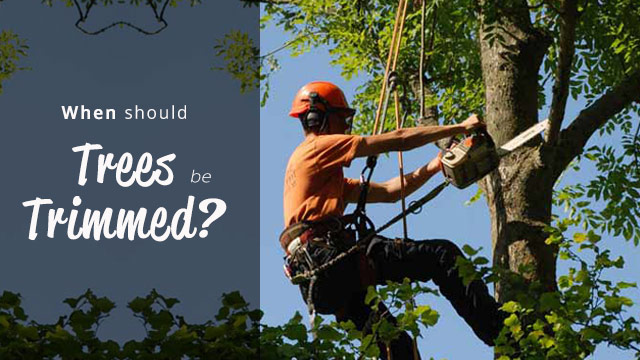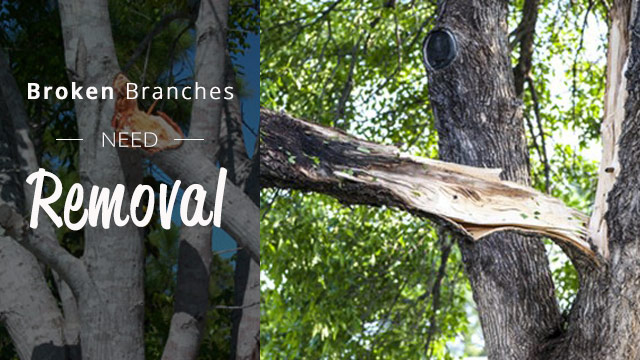Many homeowners wonder when it is the best time to trim their trees1. Can you do it any time of the year or should you wait for a favorable time? Well, the answer depends on why you want to trim and the type of tree you have.
In general, the best time to trim trees is in winter when they are dormant. Your trees will grow profusely in spring if trimmed during winter. Wait until the coldest part of the winter is over and then take out your trimming tools. Avoid trimming2 during fall as fungi and diseases can spread faster and wounds take more time to heal.
In this post, we will answer all your queries on the timing and frequency of trimming trees. You won’t need to depend on guesswork anymore and will be able to take care of your trees effectively.

What we cover
ToggleWhy should you trim trees in winter?
Winter is the ideal time to trim because-
- The trimming wounds heal faster resulting in a strong plant
- You have fewer chances of pests and diseases
- Easier to work on and trim as leaves are gone
- Tree trimming costs less in winter because tree services have less work on
Can I trim trees in summer?
Pruning in summer is not recommended as it hampers the tree’s growth and can make it vulnerable to pests and diseases. So heavy pruning should be left for winter when the trees are dormant and don’t have any leaves.
- There are a few exceptions to the rule. During summer you can-
- Remove dead, diseased, or hanging branches that pose a risk
- Shape trees by light trimming
- Summer can be a good time to trim trees when you want to limit the growth of a tree that has grown too big.
Trees that can be pruned in summer
- You can do light trimming of evergreen trees
- Fruit trees can be trimmed during summer (it may lead the plant to produce less fruit)
- Sappy hardwoods like birch, maple, and walnut trees can be pruned in summer
What is the best time of the year to trim fruit trees?
To find out the best time to trim fruit trees, you have to understand how it affects the tree. Winter is the ideal time to trim fruit trees for structural purposes. If you trim hard, your fruit tree will grow vigorously during spring.
Summer trimming is useful for limiting the growth of your tree. You can trim fruit trees in summer if they become too big. Pruning in summer also improves the quality of fruits.
The following are the ideal time to trim specific trees-
Apple: Can be pruned both during summer and winter.
Apricot: Prune during early autumn or before spring to avoid diseases and infections.
Cherry: Ideal for both summer and winter trimming.
Nectarine and Peach: Prune in summer after harvest for increasing productivity.
Plum: Suitable for both winter and summer pruning.
Quince: Light pruning is suitable both in summer and winter.
How often should I trim my tree?
How often you need to trim depends on the age, type, size, and health of the tree. Some trees like evergreens will only need to be trimmed once every 3 or 4 years and you can leave it for as long as 7 years.
On the other hand, fruit trees are trimmed every winter to encourage more fruits to grow.
- Young trees need pruning more often than adult trees. You may trim them once every 2 to 3 years.
- Once a tree starts maturing, the objectives of pruning are to maintain the health, shape, and form of the trees. Mature trees should be trimmed once every 3 to 5 years.
- You can trim off dead branches and hazardous parts of trees whenever the need arises.
A good rule of thumb for trimming trees is to undertake the job only when necessary. Also, never cut more than 25% of the growth in a single trimming.
Do pruning dead branches help a tree?
Pruning3 dead branches is a great way to ensure the health of your tree and make the surroundings safe. How does it exactly help a tree?
- Removing dead branches prevents the risks of pathogens and infections that may affect the deadwood.
- The tree gets more sunlight and air to help in photosynthesis resulting in healthy growth.
- Some trees like sweet gum can grow to 75 feet and weigh over 2,000 kg. Dead branches of big trees can damage your home and even cause death. Pruning dead branches ensures the safety of property and lives.





What to do when a branch breaks off a tree?
It is normal for trees to lose branches over their lifespan when they break off in storms. Sometimes a tree may also lose branches due to weather calamities like storms. Generally, the wound from the broken branches will heal normally with time. But the problem may arise if the tree heals too slow or doesn’t heal at all.
Wounded branch stubs provide a convenient passage for microorganisms and pathogens to enter the tree. They can cause a tree to decay if you don’t act at the right time. Sometimes the branches are also broken in an uneven and ragged manner which amplifies the problems.

So what should you do?
- Don’t go under a hanging or broken branches as it may fall on you.
- Remove any broken branches using a clean pruning cut.
- Angle the cut slightly downwards to prevent the entry of moisture.
- Use a chisel or knife to smooth the uneven edges of the wound. Don’t take away too much of the cambium (the greenish inner layer of the bark) as they carry food and water for the tree.
- Cut off any other broken branches still attached to the tree.
Can I kill a tree by over pruning?
Over-pruning means taking away more foliage or growth than necessary. Normally, your tree shouldn’t die if you leave behind some of the foliage which the tree can use to make its food.
But regular over-pruning can put stress on your tree and cause its death. The tree will become weak and won’t be able to produce enough food to sustain itself. If you remove the stronger branches during pruning, the tree can lose its strength and become weak. That increases the chances of the tree being uprooted during storms.
Over-pruning can also make the tree vulnerable to infections and decay.
To avoid over-pruning, you should never take away more than 20% to 25% of a tree’s growth in a single pruning.
Can I top a tree?
Topping a tree involves cutting the top of the tree, and minimizing the branches to stumps. Topping causes a lot of harm to the trees and should be avoided at all costs. The tree loses all its foliage which cuts down its food source. The cut-back branches also provide easy access to diseases, insects, and decay.
The tree can grow new branches, but they are often too weak to withstand the wind or storm.
Some smaller ornamental trees respond well to topping, like Crepe Myrtles, but for the most part, topping a tree is a bad idea. If you do it once, you need to do it every 2 or 3 years.
- Steph Coelho, (2021) When is the Best Time to Trim Trees for Proper Maintenance? <https://www.bobvila.com/articles/best-time-to-trim-trees/> Accessed: 23-03-2024
- Lydian Pine, (2022) 8 Common Tree Trimming Mistakes. <https://www.lawnstarter.com/blog/tree-care/common-tree-trimming-mistakes/> Accessed: 23-03-2024
- The Morton Arboretum, (2020) Pruning Trees. <https://mortonarb.org/plant-and-protect/tree-plant-care/plant-care-resources/pruning-trees/#how-to-prune> Accessed: 23-03-2024









